Article Search
Search CriteriaArticle Search:
Articles meeting the search criteria

Chil-Ustun Cave is located on the south-west of Kyrgyzstan in Osh Mountains, in 3,5 km from Aravan settlement.
A huge entrance in the cave in the form of arc with a height of 15 m and a length of basement ~ 25 m is located in the rocky group on almost plumb wall (the height under the say’s bottom) at the altitude of 1100 m.a.s.l. It’s necessary to have a definite knack and alpinist insurance is preferable to get the entrance along the steep oblique rock.
The cave has been known since ancient times, Arabian inscriptions on the walls are evidence of it.
The cave consists of 3 halls of d..

For million years, in the mountains of Central Asia, a lot of caves were formed, each of which is unique in its own way. They differ from each other by their size and depth, geological resources, in which they are formed, braided by many kilometers of labyrinths, bottomless abysses and the miraculous beauty of the underground halls.
Caves are usually formed in readily soluble geological rocks (limestone, gypsum, chalk, salt). Rain and snow waters, penetrating through barely noticeable cracks deep into the earth, micron per micron dissolve the rock, sometimes forming colossal underground hal..
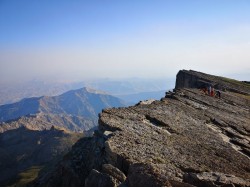
The cave named Alexander Vishnevskiy
The cave is located on the Chul-Bair massif of the Surkhantau ridge in the Surkhandarya region of the Republic of Uzbekistan.
The cave was discovered in 2015 during a joint expedition conducted by the Yekaterinburg speleo-club (GHS) and the Association of Speleologists of the Urals (ASU), a search team led by Vasily Samsonov (Orenburg), and surveyed to a length of 400 m and a depth of 70 m. The pioneers gave the cave conditional working name is ChB-15.
The cave is located in the eastern wall of the massif at an altitude of 3540 m. above sea leve..

There are more than thousand caves in Uzbekistan.
In terms of the number of caves, their depth and size, the caves of Uzbekistan are significantly ahead of all the famous caves of Central Asia taken together.
The biggest speleological discoveries in Uzbekistan started in the early 70s of XX century. As a result of these researches, more than 600 caves were discovered, including, the deepest abysses of the Asian continent: Boy-Bulok and Kievskaya, 16 km long labyrinth of Festivalnaya-Ledopadnaya cave systems.
In recent years, as a result of the persistent and fruitful work of Ural spel..
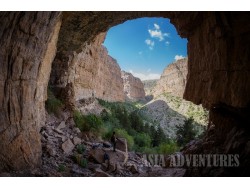
The famouse cave of the Tamerlan (Amir Temur Kuragani) is situated in the Gissar Mountains and administratively belongs to the Yakkabags district, of the Kashkadarya region of Uzbekistan.
The huge entrance to the cave is located at the foot of the Eastern wall grand canyon, slit through the river in the limestone.
To get to the cave is not easy and you need a conductor. You can try to find inconspicuous trail, which descends the stone steps into the canyon to a depth of 200 meters. The picturesque canyon about 6 miles long resembles the canyon of the well-known adventure film "Gold of th..
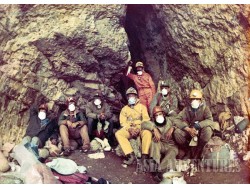
Festivalnaya-Ledopadnaya cave system is situated in Surkhandarja river near Kayrak village (Baisun region) in Hodja-Gur-Gur-Ata mountain range (part of Baisuntau mountain range). This system was also discovered by sportsmen-speleologists from Sverdlovsk (Ekaterinburg). First Yubilejnaya and Berloga caves were discovered, then the investigation of Festivalnaya cave was started. The entrance into this cave is 200 meters higher than the foot of the huge and almost vertical wall which stretches from the North to the South for 40 kilometers. The absolute reference mark of the entrance is 3445 m abo..

For millennial in the mountains of Central Asia the nature created the great number of caves, where each cave is unique in its own way. They differ from each other by their size and depth, geological formations, labyrinths that last for many kilometers, bottomless abysses and the miraculous beauty of the underground halls.
Caves usually Caves are usually formed in readily soluble geological rocks (limestone, gypsum, chalk, salt). Rain and snow waters, by penetrating to the depth of the ground, dissolve the rock, and sometimes create huge underground halls and labyrinths. Water i..
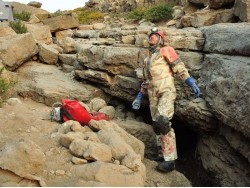
The deepest cave of the continent of Asia Boy-Bulok (1415 m) is situated in Surkhandarja region, 60 kilometers from Baysun regional center, in Chul-Bair mountain range (part of Surhantau mountain range). The inhabitants discovered the entrance into this cave a long time ago, as the whole year round a small stream flows out from it, but nobody dared to go into for a long time, especially after the event when one of the town inhabitants, a the teacher named Mustafa, vanished in the cave. Only after 20 years were his remains taken out of the cave by speleologists from Ekaterinburg (Sverdlovsk)...
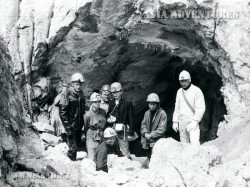
Khodja-Mumin salt group, one of the most unusual and interesting creation of nature is located in the South Tajikistan not far from Kulyab city. The huge salt mountain in the shape of dome towers above environing plain for 900 m (the altitude is 1332 m.a.s.l.). Khodja-Mumin is seen at a distance of tens kilometers. Because of the salt whiteness it seems that the mountain is covered by fresh snow. On the plan the dome has an oval shape and it’s length is as far as 8,5 km.
Khodja-Mumin and nearby Khodja-Sarkis massif are the second in the world as regards their capacity after K..

The Polatkhan cave is hidden on the plateau of the same name in Gazalkent district of Tashkent province in the mountains of South-West Tien-Shan. It was discovered by the speleologists from Novosibirsk in 1988. The following year the cave was passed through to the depth of more than 400 meters. Later in the course of the joint Tashkent and Novosibirsk expedition, speleologists reached a depth of 508 meters.
The cave consists of a vertical shaft with wells up to 80 m deep.
..
One more big cave, Kievskaya, is situated in the Urgutskij district of Samarkand region near Kamangaran village on Kirktau mountain range (part of Zarafshan mountain range). This cave was discovered in 1994 by speleologists from Kiev. As the result of 3-year investigations the maximum depth of 990 meters was reached. The cave consists of a vertical shaft and more than 30 layers joined by shafts with depths from 10 to 90 m located one over another. The cave ends with a lake of almost 10m depth. Attempts to dive with an aqualung lower than that mark failed: it was impossible to dive down throu..

The Hissar Cave is situated on the karst plateau Kyzyl-Shavar on the Hissar Range (Yakkabag District, Kashkadarya province, Uzbekistan) at an elevation of 3,530 m above sea level.
The Hissar Cave was discovered in the course of a joint expedition organised by the Ternopol and Kiev speleological clubs in 1981 and received the code T21. The cave can be entered through a little hole in the thalweg of a seasonal brook in the central part of the plateau. The cave begins with a cascade of ice-clad vertical shafts continuing to a depth of 60 m, which then pass into a system of sloping meander..

Zarkent Cave is located in the side of small river approximately 7 kms far from Zarkent settlement in Tashkent region.
The cave was founded by geologists (a chief of the party was Lyutikov S.) in 1988 during the process of searching of onyx fields. Vertical entering well didn’t allow descending into the cave to the geologists and after addressing Tashkent speleo section, the cave was gone through till the obstruction on the bottom (mark is -102 m).
The cave consists of 2 entrances. One of them by vertical 18-metered well is lead into the big hall, from this 12-metered bench is lea..

A legendary cave Hazrat-Daud is one of the most popular places of interest in Samarkand region. A legend tells that bible Tsar David (Daud) escaped from his enemies through this cave, moving apart the rocks with his hands.
Hazrat-Daud patronizes smiths (according to the legend he shaped the iron with bare hands). Thousands of pilgrims come here to touch the hand prints of Hodja-Daud on the walls of the cave, asking for health and wishes to come true.
The cave is situated in the Mirankul Mountains in 40 km from Samarkand. In the beginning of the mountain area, in a large garden are many p..
Showing 1 to 19 of 19 (1 Pages)

 Centralasia Adventures
+998712544100
Centralasia Adventures
+998712544100









